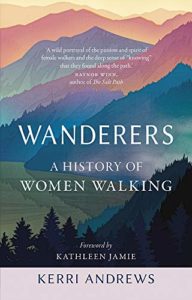
On the Nature Poetics of the Great Nan Shepherd, Bard of the Highlands
Kerri Andrews Considers What It Means to Have a Genius for Place
But in the climbing ecstasy of thought,
Ere consummation, ere the final peak,
Come hours like this. Behind, the long defile,
The steep rock-path, alongside which, from under
Snow-caves, sharp-corniced, tumble the ice-cold waters.
And now, here, at the corrie’s summit, no peak,
No vision of the blue world, far, unattainable,
But this grey plateau, rock-strewn, vast, silent,
The dark loch, the toiling crags, the snow;
A mountain shut within itself, yet a world,
Immensity. So may the mind achieve,
Toiling, no vision of the infinite,
But a vast, dark and inscrutable sense
Of its own terror, its own glory and power.
–Nan Shepherd, “Summit of Coire Etchachan”Article continues after advertisement
*
Anna, or “Nan,” Shepherd was a prolific walker and mountain writer who came to know the Cairngorms intimately over decades of what she called “traffic.” Her intimacy with the mountains was fundamental to her writing, with her three novels, poems, essays and letters shaped by her years of walking. The hills were her neighbors—she could see them from the garden of the house near Aberdeen where she lived most of her life—and they were also her sanctuary and escape.
At times she sought refuge from her employment as a lecturer in the city: an interview in 1931, given at the height of her fame, recorded how Shepherd escaped, whenever possible, to “a crofter’s house away up there on the mountainside, undeterred by Easter snows.” But occasionally she also fled to the mountains to obtain respite from her writing. “I’m going to run away from the novel yet once again before winter—end of next week—for another blessed mountain week,” she wrote to her friend and fellow writer Neil Gunn; “Aviemore this time. Perhaps I might even make more poetry, who knows. At any rate I shall see the Cairngorms—and the precipices—and the cold cold snows.” In inhospitable conditions in an often-inhospitable place, Shepherd found her home.
It was with poetry that Shepherd first attempted to capture the “burning heart of life” of the rivers in the Cairngorms, to express something of the nature of the incomprehensible, and uncomprehending, elemental forces that were at work in the mountains.
Published in 1934 in In the Cairngorms, “The Hill Burns” takes the reader on an extraordinary and unsettling journey into the deep time that still holds in the high places:
So without sediment
Run the clear burns of my country,
Fiercely pure,
Transparent as light
Gathered into its own unity,
Lucent and without colour;
Or green,
Like clear deeps of air,
Light massed upon itself,
Like the green pinions,
Cleaving the trouble of approaching night,
Shining in their own lucency,
Of the great angels that guard the Mountain;
Or amber so clear
It might have oozed from the crystal trunk
Of the tree Paradisal,
Symbol of life,
That grows in the presence of God eternally.
And these pure waters
Leap from the adamantine rocks,
The granites and schists
Of my dark and stubborn country.
From gaunt heights they tumble,
Harsh and desolate lands,
The plateau of Braeriach
Where even in July
The cataracts of wind
Crash in the corries with the boom of seas
in anger;
And Corrie Etchachan
Down whose precipitous
Narrow defile
Thunder the fragments of rock
Broken by winter storms
From their aboriginal place;
And Muich Dhui’s summit,
Rock defiant against frost and the old grinding of ice,
Wet with the cold fury of blinding cloud,
Through which the snow-fields loom up, like ghosts
from a world of eternal annihilation,
And far below, where the dark waters of Etchachan
are wont to glint,
An unfathomable void.
Out of these mountains,
Out of the defiant torment of Plutonic rock,
Out of fire, terror, blackness and upheaval,
Leap the clear burns,
Living water,
Like some pure essence of being,
Invisible in itself,
Seen only by its movement.
The poem is poised between worlds. The first is one of purity and light, an Edenic world ruled by the Christian God and overseen by his angelic train. This world is young: biblical time spans just 6,000 years, at least according to the calculations of Bishop Ussher, and the clarity of the water is suggestive of a world as yet untainted by the original sin of Adam and Eve. The second world, though, is ancient, and is characterized and created by violence and “upheaval.” This world is Hadean, and perhaps Satanic: the rocks of the mountains are enduring “torment” as a human soul might in penance, and the land has been forged by “fire.” The hill burns are brought into being by both these worlds. They emerge here from the “gaunt heights” and the “harsh and desolate lands” of Braeriach’s plateau to flow as the “essence” of life which bears no taint of its origins. The burns are therefore both ancient and new, but what might have been a contradiction is resolved in the poem by Shepherd’s description of them “being”: the continuous tense is able to contain both past and present within it.
As a walker, Shepherd found the “elementals” of water and ice, and their effects on the landscape, intriguing but unsettling.
Nor was Shepherd any less awed by what happens to the mountains’ waters when they grew still in the winter freeze. With so much ground over 4,000 feet in height, the Cairngorms experience a climate more typically seen in the high northern latitudes, one of “rasping” winds and “scouring” avalanches. Its passes were once giant roads for ice, and the slopes of its high mountains and many eastern-facing corries can hold snow the year round. As a walker, Shepherd found the “elementals” of water and ice, and their effects on the landscape, intriguing but unsettling; as a result, her writing never romanticizes their power, even as she expresses a profound love for the ways in which they have sculpted the mountainside. And Shepherd knew directly what snow and ice could do to frail human bodies. In the time of her youthful acquaintance with the mountain, four people “were lost in a blizzard,” while another slipped to his death on a patch of snow, “in May.”
Looking back thirty years later, in preparation for the publication of The Living Mountain in 1977, Shepherd had an even sorrier litany to recount. During that time—which “in the life of a mountain is nothing”, but was, to some of the human existences she recalled, everything—many tragic things had occurred in the snows of the mountains:
A man and a girl are found, months too late, far out of their path, the girl on abraded hands and knees as she clawed her way through drift. I see her living face still (she was one of my students), a sane, eager, happy face. She should have lived to be old. Seventy men, with dogs and a helicopter, go out after a lone skier who has failed to return, and who is found dead. And a group of schoolchildren, belated, fail to find the hut where they should have spent the night. They shelter against a wall of snow, but in the morning, in spite of the heroic efforts of their instructress, only she and one boy are alive.
Shepherd’s sadness at the fate of her former pupil, in particular, is evident, with the use of the present tense bringing these tragedies, spread over half a human lifetime, hauntingly back into the present. But such emotion was balanced elsewhere with a cold rationality about the risks of mountain walking. Declining to pass judgement on the decisions that brought so many people to such bleak ends, Shepherd instead saw such choices as part and parcel of an important quest to know the mountains. Such danger “is the risk we must all take when we accept individual responsibility for ourselves on the mountain,” she wrote, “and until we have done that, we do not begin to know it.”
Shepherd accepted that “individual responsibility.” Eschewing any grander aim, she spent one “whole midwinter day wandering from one burn to another,” simply watching the “fluctuation between the motion in water and the immobility of frost.” Elsewhere, though, the constant shifting of the snow meant that any understanding of the mountain was temporary, a boon granted for a moment but easily withdrawn by a change in the wind. While “Loose snow blown in the sun looks like the ripples running through corn,” it could also “blow past in a cloud, visible as it approaches, but formed of minute ice particles, so fine that the eye cannot distinguish them individually as they pass.” Shepherd captured the shifting patterns of her mountain-knowing best in poetry; the simplicity of the title, “Snow,” understating the complexity of the natural and human agents at work in the poem:
I did not know. How could I understand,
I, who had scorned the very name of love?
Clear were my eyes and heaven was clear above;
Clarity held the long lines of the land;
Hill after hill raced proud at my demand.
Too careless to be triumphant, O enough
Of triumph had I who knew the transience of
Clear cloud and wind: clear colour; earth blown
and tanned.And now—and now—I am mazed to find my world
Sore altered in the passing of a night
(And never a dream all night had round me curled)
No sound, no proclamation, no delight
Of haunting prophecy came, no hurricane swirled.
But at morn the earth was strange, a blur, white.Article continues after advertisement
Shepherd’s poem holds in tension knowing and not knowing, though the distinction between the two, like the outlines of the land, is “blurred” by the snow. The speaker is an experienced frequenter of the mountains who knows enough to appreciate “the transience of / Clear cloud and wind,” to know that mountain weather rarely lasts for long.
Yet knowledge is also posited as an impossibility from the very beginning of the poem, from the first four words, which proclaim, simply, “I did not know.” Knowing, then, is not the same as “clarity,” which is an idea that reverberates throughout the opening stanza, first as a quality of sight, then of weather and then of power: it is “clarity” that holds “the long lines of the land,” and which cause the optical illusion of lines of hills “racing proud” into the distance at the speaker’s volition. But neither sight, clarity nor knowledge is sufficient to understand the appearance of the snow, which materializes in the second stanza with none of the warning signs that would have made its presence comprehensible. Nothing is the same following the snow’s fall—not the land, not the view, and certainly not the speaker, who is left uncertain of everything as a result of the overwhelming surprise as the earth is rendered utterly “strange.”
True knowledge of the mountains is only possible through the suffering of the body brought on through the relentless motion of the feet.
Knowing, for Shepherd, was hard-won through physical experiences that were painful and perilous: those experiences add a tang to the work. In the eastern Cairngorms, in what should have been the beginning of spring, Shepherd herself made an “error of judgment”:
On that late April day, after some halcyon weather, a sudden
snow storm blew up. It snowed all night—thick heavy snow
that lay even under the next day’s sunshine. We were going
to the Dubh Loch of Ben a’ Bhuird, with no intention of a
summit, and I had taken no precautions against exposure;
I had expected neither frosty wind nor hot sun to play
havoc with my skin, nor had I had till then any experience
of strong light upon snow. After a while I found the glare
intolerable; I saw scarlet patches on the snow; I felt sick
and weak. My companion refused to leave me sitting in the
snow and I refused to defeat the object of his walk, which
was to photograph the loch in its still wintry condition; so
I struggled on, with his dark handkerchief veiling my eyes—
a miserable blinkered imprisonment.
The description of being blinded by snow makes for uncomfortable reading, not least because of Shepherd’s self-admonitory remark that her discomfort “might have [been] avoided had I remembered that snow can blow out of a warm sky”: this is a lesson painfully learned. In Shepherd’s writing, though, true learning—like hill-walking—is arduous. True knowledge of the mountains is only possible through the suffering of the body brought on through the relentless motion of the feet. Without this suffering, though, it would have been impossible for Shepherd to write.
In her explorations of the rivers and inside spaces of the mountains, Shepherd often left paths behind, choosing to pursue instead unmarked routes which bore no trace of pedestrian traffic. “Eye and foot acquire in rough walking,” Shepherd wrote in The Living Mountain, “a co-ordination that makes one distinctly aware of where the next step is to fall.” This knowledge becomes so intuitive that the feet learn to position themselves without conscious thought; Shepherd recounts one occasion when racing down a heather-clad hillside, her body independently avoided two adders, leaving her “to consider with amused surprise the speed and sureness of my own feet.”
While Shepherd took considerable pleasure in such “rough walking,” the following of paths also played an important part in how she understood the mountains, and her place within them. Robert Macfarlane has written of paths as “offering not only means of traversing space, but ways of feeling, being and knowing,” while Rebecca Solnit describes them as “a record of those who have gone before, and to follow them is to follow people who are no longer there.” Both ideas seem to be at work in the meaning Shepherd found in the Cairngorms’ paths:
Up on the plateau nothing has moved for a long time. I
have walked all day, and seen no one. I have heard no living
sound. Once, in a solitary corrie, the rattle of a falling stone
betrayed the passage of a line of stags. But up here, no
movement, no voice. Man might be a thousand years away.
Yet, as I look round me, I am touched at many points by
his presence. His presence is in the cairns, marking the summits,
marking the paths, marking the spot where a man has
died, or where a river is born. It is in the paths themselves;
even over boulder and rock man’s persistent passage can be
seen, as at the head of the Lairig Ghru, where the path, over
brown-grey weathered and lichened stones, shines as red as
new-made rock. It is in the stepping-stones over the burns,
and lower in the glens, the bridges.
Shepherd is alone and is yet in the company of numberless others who have trodden the routes visible from her lofty vantage point, whose marks on the rock have remained visible long after they passed. It is a kind of haunting, though a companionable one; the landscape is littered with the physical traces of people perhaps now dead, but those traces are evidence of people’s lives and experiences. Shepherd’s isolation is therefore only partial; total separation from other humans may not be possible where there are paths, which serve as links between not only places, but people, and which cross not only space but time.
Paths could also serve as links between different realms of experience. Shepherd recounts how one snowy day she found herself “companioned” on the path, not by humans leaving traces of their footsteps, but by the tracks of animals and birds, laid down in the hours since the snow stopped. The presence of these tracks transforms the space from an “empty world” into a populous one in which humans and animals comfortably and amicably co-exist. That morning, Shepherd was able to see evidence of a “hare bounding, a hare trotting, a fox dragging his brush, grouse thick-footed, plover thin, red deer and roes.” These creatures are fellow path-makers and path-followers, and as a result, there is a sense of empathy in Shepherd’s writing that enables human experience to come close to animal, and vice versa. This was an important aspect of “companioned” walking. For Shepherd, “The perfect hill companion is the one whose identity is, for the time being, merged in that of the mountains, as you feel your own to be,” so that distinctions between animal or human, living being or rock, cease to matter.
The greatest gift of Shepherd’s writing is that she outlines how our feeling, walking selves are the means by which we gain insight into the inner mysteries both of the world and of human existence.
In 1940, not long before The Living Mountain was likely begun, Nan Shepherd wrote to Neil Gunn about his two latest novels, Wild Geese Overhead, published the year before, and Second Sight, which had just appeared. She had enjoyed both but had particularly loved the latter. Not because of the theme, or any consideration of its implications: but because of the uncanny way you enter my breathing and living and seeing and apprehending. To apprehend things—walking on a hill, seeing the light change, the mist, the dark, being aware, using the whole of one’s body to instruct the spirit—yes, that is a secret life one has and knows that others have. But to be able to share it, in and through words—that’s what frightens me. The word shouldn’t have such power. It dissolves one’s being. I am no longer myself but part of a life beyond myself when I read pages that are so much the expression of myself. . . . you can take movements of being and translate them out of themselves into words. That seems to me a gift of a very high and rare order.
Shepherd was in awe of Gunn’s ability to “share” the “movements of being” that are the core of human existence, to articulate the “secret life” within each of us. In The Living Mountain, she would match his accomplishments. Here she would succeed in “sharing” through her prose an understanding of what it is to come to truly know a place, to walk knowledge into oneself, to “discover the mountain in itself.” Such knowledge was a gift, and The Living Mountain serves in part as an acknowledgement of all that walking with the mountains has given to Shepherd, the most precious of all being “a life of the senses so pure, so untouched by any mode of apprehension but their own” that the individual is finally able to encounter what Shepherd called “the total mountain.”
It is perhaps the greatest gift of Shepherd’s writing that she outlines how our experiencing, feeling, walking selves are the means by which we gain insight into the inner mysteries both of the world and of human existence, that “The more one learns of this intricate interplay of soil, altitude, weather, and the living tissues of plant and insect . . . the more the mystery deepens.” The pursuit of mystery sustained Shepherd throughout her life, despite old age and infirmity. Confined physically by the failing of her body as well as the walls of her nursing home in Banchory, Shepherd’s mind continued to roam, finding magic in the “ordinary world” that brought joy in her last months. Even at the end, she persisted in living “all the way through.” Asked by Jessie Kesson whether she believed in an afterlife, Shepherd replied, “I hope it is true for those who have had a lean life.” For herself, though, her own life “has been so good, so fulfilling.” It was a life lived with as much as in the hills of Aberdeenshire, and which ended in sight of those life-long friends.
*
It was October in the Cairngorms, and overnight a hoar frost had glazed grass and tree with a smooth, shrouding ice that scattered the tentative early morning sun into shards. Those faster with their boots and bags stood with their hands in their armpits, or jumped up and down while others fumbled with their laces, chilled fingers clumsy in the freezing air. Ready at last, we set off at a brisk pace, the cold making us eager to be on the move. Overhead the sky was a perfect blue, the color as sharp as the air. We planned to walk to Derry Lodge, and from there to ascend Derry Cairngorm and Beinn Mheadhoin, “the middle hill,” whose Gaelic name recognizes the mountain’s position at the center of the Cairngorms massif even as it belies its considerable steepness. Hidden between the two peaks lay Loch Etchachan, its deep waters nestling snugly in the tight bowl of Coire Etchachan, where it is watched over by some of the highest mountains in Britain. If there is a place that can be considered the heart of the Cairngorms, it is Coire Etchachan, where routes to all points of the compass cross. But even on that perfect autumn day, bright lit by a chilled sun, it was a barren heart made of grey rock that had been sliced by water where it had not been smashed by ice. We fled from it, upwards, eager for a wider, shallower field of vision that did not force us to look deep into the earth, or ourselves.
When I next walked the mountains of the Cairngorms, it was with Shepherd in mind, and in my rucksack.
When Nan Shepherd stood on that same spot during a summer eighty years before, her reaction could not have been more different. We were afraid to be exposed to the mountain’s insides, to feel enclosed, perhaps even entombed by the place, but Shepherd found in this confined space a snugness that was both revelatory and comforting. The mountain became, for a time, a fortress, with its “soaring barricade” of “towering mountain walls” enclosing loch, landscape and woman. Perhaps if I’d have had her words to comfort me, I would have found the courage to enjoy the uncomplicated brutality of the place, but our acquaintance was a year away, and I was afraid.
When I next walked the mountains of the Cairngorms, it was with Shepherd in mind, and in my rucksack. It was my 35th birthday, and I had chosen to climb Bynack More. Like Coire Etchachan, it had been, for Shepherd, a place of interiorities, a place where she found she could access the cold elemental heart of the Cairngorms. I walked to the Barns of Bynack after reaching the mountain’s summit, eager to see the rock-house she had described and to climb the staircase and to look out of the window as she had done: I would take temporary possession of a grand home made from stone, I thought, and play at being laird of the mountain.
What I found was a towering eminence of black rock, all smooth sides and curves like a child’s drawing of a cloud made hardly real, penetrated on the northern side only superficially by a few mossy clefts. The startling, lively green of the vegetation made a pleasing contrast with the dour sheen of the stone beneath, but such color is only possible in the presence of water: any attempt to climb these slits would result in a potentially lethal slip on the edgeless rock. Only one cleft in the Barns was dry on that cloudless day: a huge schism that, from the south, looked to have cleaved the giant rock almost in two. But even this seemed dangerous to me—while the up scramble might have been possible, I had less confidence in my ability to get down again. Less brave than Shepherd, I was forced to enjoy the Barns from the outside, and to take what solace I could from the “startling view” on my return to Bynack More’s summit cairn, the preserve of “beginners” and “the talking tribe” who know no better.
In the years since I walked Bynack More, I have continued to try to understand the pull of the mountain interior that so thrilled and drew Nan Shepherd.
In the years since I walked Bynack More, I have continued to try to understand the pull of the mountain interior that so thrilled and drew Nan Shepherd, but I am no match for her. Instead, it seems I must make do with the mountains’ surfaces: boulders, heather, ski tracks, cotton grass, scree, summit cairn, scattering of sunlight off quartz, “tang” of mountain height. It is enough.
__________________________________

From Wanderers by Kerri Andrews. Used with the permission of Reaktion Books. Copyright © 2020 by Kerri Andrews.
Kerri Andrews
Kerri Andrews is a senior lecturer in English literature at Edge Hill University. She has published widely on women's writing, especially Romantic-era authors, and is a keen hill-walker and member of Mountaineering Scotland.












